2018 February
About Andrew Cusack
 Writer, web designer, etc.; born in New York; educated in Argentina, Scotland, and South Africa; now based in London.
Writer, web designer, etc.; born in New York; educated in Argentina, Scotland, and South Africa; now based in London. read more
News
Blogs
Reviews & Periodicals
Arts & Design
World
France
Mitteleuropa
Knickerbockers
Argentina
The Levant
Africa
Cape of Good Hope
Netherlands
Scandinavia
Québec
India
Muscovy
Germany
Academica
Trad Flag
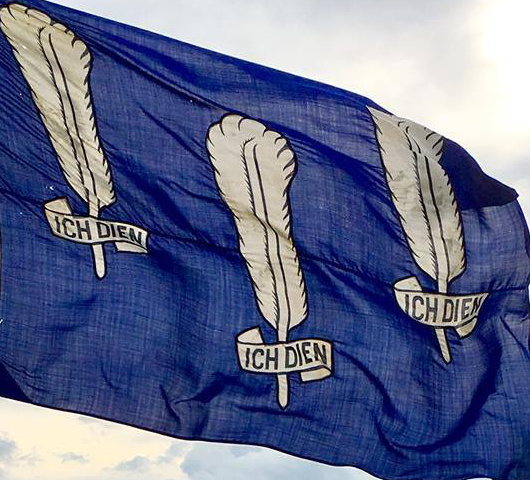
When a cardinal dies his galero is suspended aloft above his tomb to slowly rot and wither away, thus showing the eventual fate of all earthly things. Unlike galeros, the construction and manufacture of flags has “advanced” much in the past century in the sense that they are now made of virtually indestructible materials. This renders them useful for long-term outdoor display but is somewhat lacking in texture, feel, and look.
Earlier flags were made of materials that allowed them to grow old gracefully adding dignity with each passing year, whereas today more often than not they are printed on synthetics. Sewn flags are still available, if at slightly greater cost, and are a good way to keep things smart.
I love a good trad flag though, and Oriel College Boat Club – a festive institution well known for the quality of both its rowing and its conviviality – has a perfect example of one (above and below). From my admittedly unexpert eye, I’d say it’s printed on cotton. Perhaps others know more.
A handsome banner that I dare say outsmarts any of its neighbours in the row of boathouses along the Isis.

Recent Reads
Few things are more enjoyable then a good old-fashioned take-down, and philosopher John Gray delivers the goods with this wonderful review of the latest book by the psychologist and “popular science” writer Steven Pinker, a “feeble sermon for rattled liberals”.
Meanwhile, the inestimable Pee Eee Gee – Pascal-Emanuel Gobry – argues that France’s reigning concept of laïcité is of much more recent vintage then its proponents claims.
The 1905 law ended public subsidies for religious institutions, but instituted no legal or cultural rule against public expression of religious values. So, why are we now told differently?
My only extremely tenuous brush with celebrity is that my Irish teacher (go raibh maith agat, Áine!) happened to tutor on-set the actress who played Luna Lovegood in the Harry Potter films. Among the sort of Dublin people who manage to continually drop into conversation that they went to Trinity, there is a (further) irritating tendency to look down upon the Irish language and use disdain for it as yet another attempt to assert their fragile sense of social superiority.
It is a contemptible and false dichotomy to think that if you appreciate Georgian architecture or Henry Grattan you can’t appreciate the Irish language or Éamon de Valera. Tiresome boors will always try to sell us such dichotomies, but we will not have them.
Paltry though my attempts to learn more Irish have been, what little I’ve picked up has been extremely rewarding and given better insight into the way English in Ireland is spoken and written. (Do the experts still call it “Hiberno-English”, I wonder?) It’s been a pleasure over the past however-long to see Michael Brendan Dougherty – one of America’s most talented journos and a fellow Irish New Yorker – share his own experiences with the Irish language.
MBD’s most recent books column at National Review explores two books concerning Irish, and moves from the Gaeltacht of the mind to a book about Leopolis/Lwów/Lviv/Lemberg in Galicia. City of Lions, incidentally, is published by Pushkin Press, which has proved an almost inexhaustible source of good reads (e.g. Oliver VII).
The recent read I most enjoyed, however, is Gordon Campbell’s delightful combative romp through English translations of the Bible, Making God Speak English. The professor sheds particular light on the thriving culture of pre-Reformation translations of holy writ in the vernacular in general and the English tongue in particular, bursting numerous bubbles of Protestant mythology along the way.
Par example:
Wyclif is a seminal figure in the long road to the catastrophe of the Reformation, with its legacy of decades of wars of religion and centuries of interconfessional animosities that live on in the twenty-first century, but the idea that he was the first translator of the complete Bible into English is a myth. The Middle English Bible, as Henry Ansgar Kelly calls it in his recent reassessment, was in Professor Kelly’s authoritative view neither the work of Wyclif nor of his Lollard followers, but was rather a wholly orthodox Bible with origins in the University of Oxford. It was immensely popular, because it enabled readers and their listeners to understand the readings from the Bible that they heard at Sunday Mass.
I learnt much from Prof. Campbell’s enjoyable submission and you might too.
The Port of London
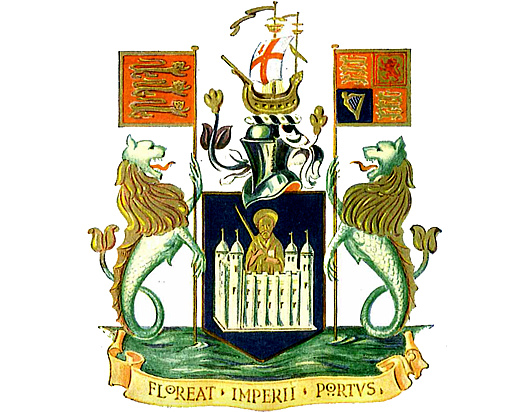
Officially there are or have been various Londons: first the City of London, founded in AD 43 and a mere square mile to this day, then the County of London created in 1889, and the creature called Greater London has also existed in varying shapes and forms since 1965.
But there is also the Port of London, which has existed since the first century and was once the busiest port in the world, bringing the riches of empire to the metropolis from the four corners of the earth.
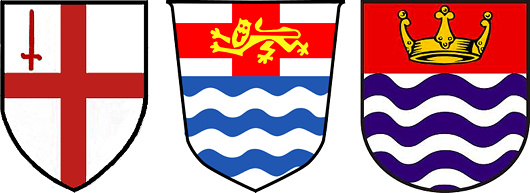
The arms of the City of London, London County Council, and Greater London Council.
All these Londons, of course, have over the centuries been granted or assumed their own coats of arms as heraldic emblems of their importance. The Port of London Authority was created in 1908 by an Act of Parliament which some scholars argue is the first law in the world mandating codetermination or workers’ participation in the board.
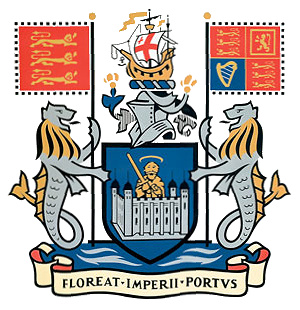 Its coat of arms was granted a year later in 1909 and features on its shield Saint Paul, the patron saint of London bearing his usual sword, issuing forth from the Tower of London.
Its coat of arms was granted a year later in 1909 and features on its shield Saint Paul, the patron saint of London bearing his usual sword, issuing forth from the Tower of London.
The crest above the shield is a galley bearing on its mainsail the arms of the City of London — the Lord Mayor is ex officio the Admiral of the Port of London.
Sea lions act as supporters, also bearing standards of the royal arms of England and of the United Kingdom, while the motto proclaims in Latin May the Port of the Empire Flourish.
For proper heraldry nerds, the arms are blasoned:
Shield: Azure, issuing from a castle argent, a demi-man vested, holding in the dexter hand a drawn sword, and in the sinister a scroll Or, the one representing the Tower of London, the other the figure of St Paul, the patron saint of London.
Crest: On a wreath of the colours, an ancient ship Or, the main sail charged with the arms of the City of London.
Supporters: On either side a sea-lion argent, crined, finned and tufted or, issuing from waves of the sea proper, that to the sinister grasping the banner of King Edward II; the to the sinister the banner of King Edward VII.
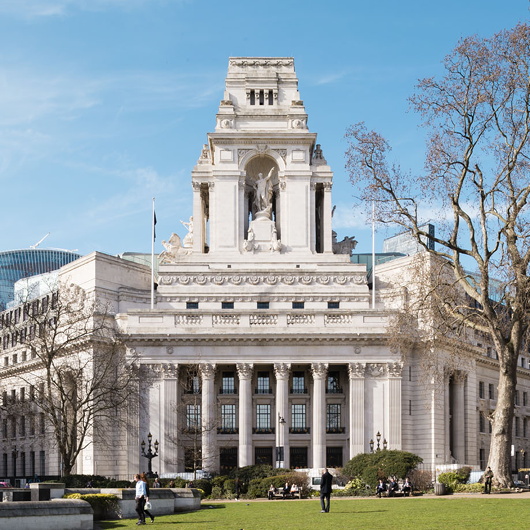
Befitting the Port of the Empire, the Authority built a grandiose headquarters at 10 Trinity Square, overlooking the Tower of London featured in its coat of arms.
The PLA moved out ages ago and the building is now a hotel, but it often features in films and television as a government (most prominently in the 2012 James Bond film ‘Skyfall’).
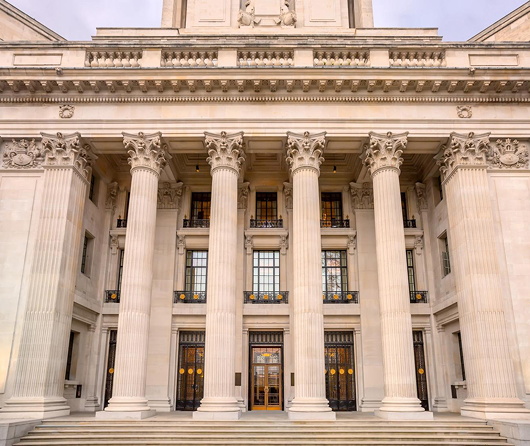
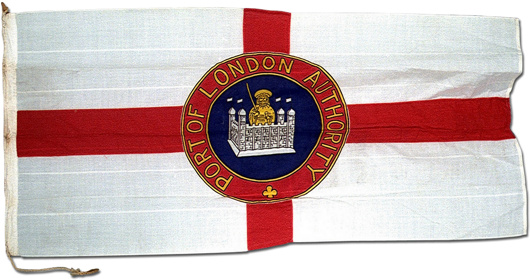
The Port of London Authority has its own flag (above) as well as its own ensign — a blue field with a Union Jack in the canton and in the fly a golden sea lion bearing a trident. Distinctive pennants also exist for the Chairman and Vice Chairman of the Authority. (These can be seen here.)
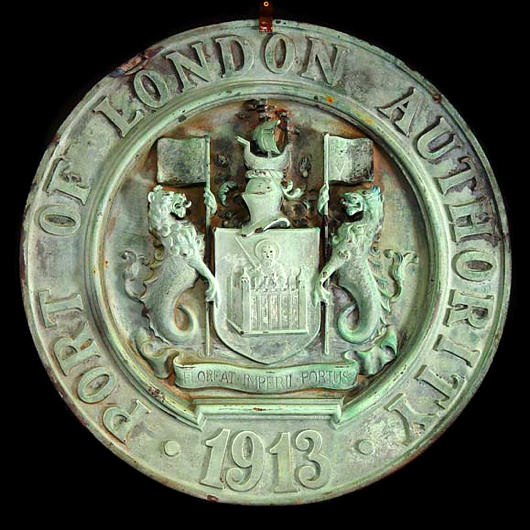
After its foundation the PLA rationalised the layout and organisation of London’s dock system, and their significant constructions allowed the Port to displays its arms on numerous buildings. One such display (above) was recently sold by Westland London.
The main shipping terminal of London is now far down-river at Tilbury and the Authority no longer owns any docks. Its duties however are still numerous — control of Thames ship traffic, navigational safety, pier & jetty maintenance, and conservation — so the century-old Authority still keeps itself quite busy looking after a millennia-old port.
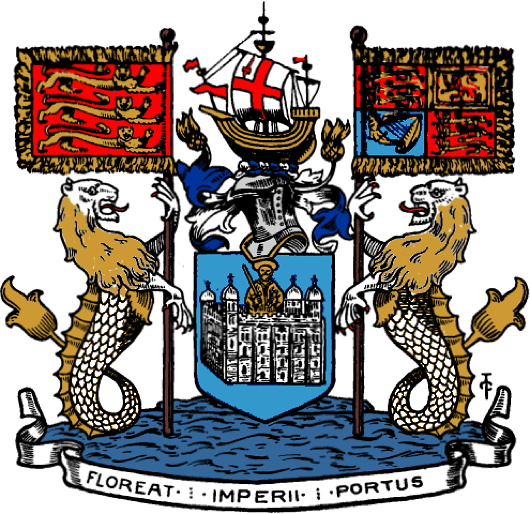
Albert Power & Arthur Griffith
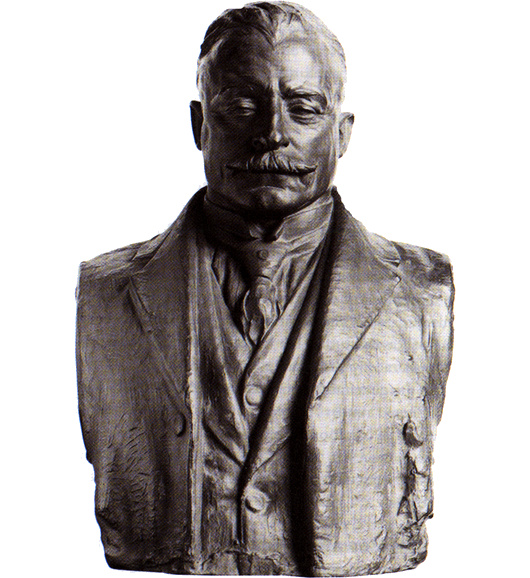
These days the Irish sculptor Albert Power is very rarely spoken of, and I can’t claim to know much about this bronze bust he did of the founder of the original Sinn Féin, Arthur Griffith.
It might be in the National Gallery in Dublin, though I didn’t notice it when I nipped in there with my sister the other day. More likely it is in Leinster House, where there are other busts of prominent figures of 1916-1921 by Albert Power and the better-known Oliver Sheppard.
Unlike Sheppard, Power was a Catholic, which is probably why he was chosen to sculpt the funerary monument of Archbishop Walsh of Dublin who died in 1921. He submitted designs for the new Irish coinage but the Free State wisely chose the far superior set designed by the English sculptor Percy Metcalfe.
As for the subject of this work of art, the Royal Irish Academy’s Dictionary of Irish Biography describes Griffith as “a lucid writer with a vivid turn of phrase”.
The first newspaper he edited was in South Africa where he took the helm of the Middelburg Courant in 1897, attempting to persuade the English-speaking readers with his Boer-friendly views. “I eventually managed to kill the paper,” Griffith wrote, “as the British withdrew their support, and the Dutchmen didn’t bother reading a journal printed in English – the Dutch were quite right.”
Griffith founded Sinn Féin more as a pressure group to support his pet project of reviving the “King, Lords, and Commons” of Ireland, influenced by the Austro-Hungarian Ausgleich of 1867. Independence, he argued, would satisfy the nationalists, while the shared monarchy would keep the unionists happy. In the event, neither half were much enthused by the prospect.
In the aftermath of 1916, Griffith came into his own as a leader and statesman rather than an agitating journalist. His role in the War of Independence and the Treaty negotiations is well known. Without his persuasive arguments in debates, it is highly unlikely the Dáil would have approved the Treaty.
Gloomy civil war soon overshadowed everything, but Griffith died of a cerebral haemorrhage on 12 August 1922 – just ten days before Collins was killed in ambush at Béal na Bláth.
The Steps of the Throne
Who may sit on the steps of the throne in the House of Lords?
Much was made of the Prime Minister’s decision to sit in the House of Lords when they were going through stages of the bill to invoke Article 50 last year. Theresa May had the right to sit on the steps of the throne in the Lords chamber by virtue of being sworn to the Privy Council, as all holders of the four Great Offices of State are (and usually their opposition Shadows as well).
But who else is granted the privilege of lodging their posterior in such a prominent locale?
The Companion to the Standing Orders and Guide to the Proceedings of the House of Lords provides some guidance:
1.59 The following may sit on the steps of the Throne:
· members of the House of Lords in receipt of a writ of summons, including those who have not taken their seat or the oath and those who have leave of absence;
· members of the House of Lords who are disqualified from sitting or voting in the House as Members of the European Parliament or as holders of disqualifying judicial office;
· hereditary peers who were formerly members of the House and who were excluded from the House by the House of Lords Act 1999;
· the eldest child (which includes an adopted child) of a member of the House (or the eldest son where the right was exercised before 27 March 2000);
· peers of Ireland;
· diocesan bishops of the Church of England who do not yet have seats in the House of Lords;
· retired bishops who have had seats in the House of Lords;
· Privy Counsellors;
· Clerk of the Crown in Chancery;
· Black Rod and his Deputy;
· the Dean of Westminster.
Pretoria Philadelphia
Andries Pretorius grew up on his father’s farm near Graaf-Reinet in the Cape of Good Hope, but the Great Trek took him (and many other Boers) into the South African interior. Pretorius’s victory, against all odds, over Dingane’s Zulu forces at Blood River in 1838 was to be commemorated from that day forevermore by Afrikaner piety as Geloftedag — the Day of the Vow. When the South African Republic (ZAR) was established in 1852 the capital was Potchefstroom, but Andries’s son Marthinus founded the city of Pretoria Philadelphia in 1855 to be the new capital of the Transvaal.
The four colonies at the end of the continent were conjoined in 1910 as the Union of South Africa, with Pretoria (as it was soon shortened to) named the seat of the executive and thus the nation’s capital. The parliament met in Cape Town and the highest courts in Bloemfontein so that, in some sense, the new nation had three capitals — administrative, legislative, and judicial. As the seat of the visible sovereignty of the realm, the Governor-General, as well as the Prime Minister’s administration and cabinet, however, it was Pretoria that held precedence.
We’ve already examined Kerkplein — Church Square — at the heart of the city, but the rest of the capital is worth exploring further. (more…)
Search
Instagram: @andcusack
Click here for my Instagram photos.Most Recent Posts
- Sag Harbor Cinema March 26, 2025
- Teutonic Takeover March 10, 2025
- Katalin Bánffy-Jelen, R.I.P. March 3, 2025
- Substack Cusackiensis March 3, 2025
- In the Courts of the Lord February 13, 2025
Most Recent Comments
Book Wishlist
Monthly Archives
Categories


